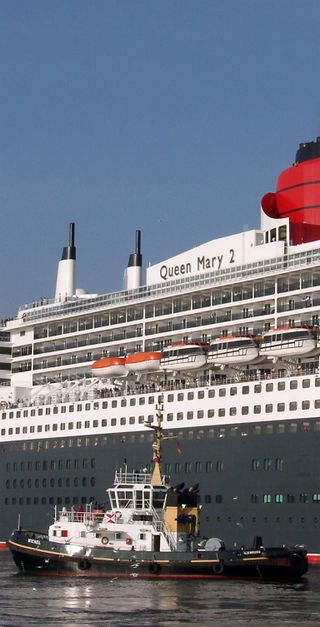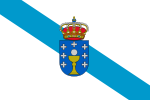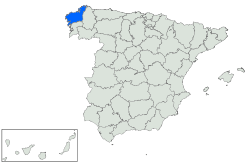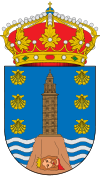Province of A Coruña
The province of A Coruña (also: Spanish: La Coruña, and Corunna in English[1]) is the most North-western Atlantic-facing province of Spain, and one of the four provinces which constitute the autonomous community of Galicia. This province is surrounded by the Atlantic Ocean to the West and North, the Pontevedra Province to the South and the Lugo Province to the East.
Transport
Airports and airfields
Railway
- Spanish National Railway Network Linking every single major City: Ferrol, Betanzos, A Coruña and Santiago de Compostela
- Spanish Narrow-Gauge Railways Linking the City of Ferrol with different towns of Ferrol and Ortegal. This line is also known as Ferrol-Irun (Basque Country)
- Spanish High Speed Railway Network (AVE) Linking most major cities of the province with Lisbon and Madrid is under construction and sometime in the future will be a reality (Possibly, before the end of the next decade)
Economy
Ports
- A Coruña - Major Commercial Port - Costa da Morte
- Malpica - Fishing Port - Costa da Morte
- Camariñas - Fishing Port - Costa da Morte
- Fisterra - Fishing Port - Costa da Morte
- Ferrol - Major Commercial Ports (also: Military) - Rias altas
- Cariño - Fishing Port - Rias altas
- Espasante - Fishing Port - Rias altas
- Cedeira - Fishing Port - Rias altas
National park
- Atlantic Islands of Galicia National Park[2] is the only National Park in Galicia. It is shared between the Provinces of A Coruña and Pontevedra.
Natural parks
- The "Fragas" of the River Eume Natural Park extends itself throughout the Eume and Ferrol regions of Ferrolterra.
- The Dunes of Corrubedo Natural Park (Parque Natural del Complejo Dunar de Corrubedo y Lagunas de Carregal y Vixánis) is a beach park at the very end of the Barbanza Peninsula.
International World Surf Competitions
- The Ferrolterra Pantin Classic gathers every year some of the most international and remarkable figures in the world of surf
- Doninos, Esmelle and St. George's Beach the north of the province is very privilege for the quality of its beaches a most of them are ideal for Water Sports like surfing.
History of the Province

In recent years, Ferrol and
A Coruña have become popular stops for transatlantic steamships in route to the
Mediterranean.
The history of this province starts at the end of the Middle Ages during the reign of the Catholic Kings of Spain. During those years this province was far smaller than today. This is because in the 1833 territorial division of Spain the entire Province of Betanzos together with half of the Mondoñedo were amalgamated into one single province with its capital city in A Coruña. That was going to be the beginning of a love hate relationship between the major cities caught in between: Ferrol, Santiago de Compostela and A Coruña. Due to this unusual situation, the dioceses of these parts of Galicia do not match any longer with the administrative divisions. In addition, the capital city of the province has never had a cathedral, but both Ferrol and Santiago de Compostela have one. The City of Santiago de Compostela is not the provincial capital, but has always been the Capital of Galicia and historically a rival to Toledo for being the most important city in Spain ecclesiastically speaking. Since 1833, the Province of A Coruña has always been the one with the largest population and largest coast. Until the second half of the 20th century, this province was both the religious and cultural centre of the entire region. The University of Santiago de Compostela was the only university in North-western Spain until the arrival of democracy after the death of General Francisco Franco.
The Industrial Revolution: Ferrol
The City of Ferrol in the Province of A Coruña was one of the first places, not just in Galicia but in Spain to experiment and suffer from the entire set of socioeconomic changes which affected the United Kingdom in the first half of the 18th century and the United States and some parts of Europe a century later. As a consequence of that, Ferrol will be one of the first shipyards in the world to produce wooded ships covered with copper sheets in the early years of the 19th century, and by the end of the same century, the same shipyards were producing iron armoured ships. Ferrol was at one point the largest city in Galicia, the place of birth of people like Pablo Iglesias Posse the founder of the Spanish Socialist Workers' Party, Concepción Arenal founder of the Spanish Feminist Movement, the Franco Brothers one pioneer of world’s aviation and the other hero of the Spanish Second Republic during the early years of the 20th century.
The Peninsular War
In the Peninsular War, Sir John Moore headed a 30,000-strong British Force, which attacked Napoleon near Burgos, but they were soon forced into a long retreat chased by the French, ending in an evacuation from A Coruña in January 1809 in the Battle of Corunna (also known by its many variants and as the "Battle of Elviña". Moore was killed by a cannon shot while directing the defence of the town. His burial inspired a well-known poem.
Spanish Civil War
- Battle of La Corunna Road Fought in the outskirts of Madrid literally on the road which led at the time to the Province. (13 December 1936 to 15 January 1937).
The Second World War
The following German U-Boats has been reported as sunk somewhere along the A Coruña province's coast:
- U-514 - sunk 8 July 1943 north-east of Cape Finisterre, Spain. 54 dead (all hands lost)
- U-504 - sunk at 1543hrs on 30 July 1943 in the North Atlantic north-west of Cape Ortegal, Spain. 53 dead (all hands lost)
- U-508 - sunk 12 November 1943 in the Bay of Biscay north of Cape Ortegal, Spain. 57 dead (all hands lost)
The Province and City of A Coruña during the 20th Century
| A Coruña Province Population c. 1787 |
| District |
population |
| City of Coruña |
13,575 |
| City of Ferrol (Civilian Pop. Only) |
24,993 |
| Santiago de Compostela |
15,584 |
| Towns, Villages and Hamlets |
c.229,123 |
| All the Province (Total): |
283,275 |
| (Ferrol - Urban History, 2004) [1] |
| A Coruña Province Population c. 1833 |
| District |
population |
| City of Coruña |
23,000 |
| City of Ferrol (Civilian Pop. Only) |
13,000 |
| Santiago de Compostela |
28,000 |
| Towns, Villages and Hamlets |
c.233,000 |
| All the Province (Total): |
c.297,000 |
| (U. P. Gazetteer By Th.Baldwin, 1847) [2] |
| A Coruña Province Population c. 1900 |
| District |
population |
| City of Coruña |
43,971 |
| City of Ferrol (Civilian Pop. Only) |
25,281 |
| Santiago de Compostela |
24,120 |
| Towns, Villages and Hamlets |
580,184 |
| All the Province (Total): |
653,556 |
| (Encyclopædia Britannica, 1911) s:User:Tim Starling/ScanSet PNG demo |
After the Battle of Trafalgar (1805), and the War of Independence (1808–1814) the fortune’s of El Ferrol started to go into decline. This is how the largest port in northern Spain, site of one of the three Royal Dockyards, together with Cartagena and Cadiz, almost became a "dead" town during the reign of Ferdinand VII. By 1833 the City and Naval Station of Ferrol saw its civilian population reduced to just 13,000. [3] Even though, during the administration of the Marquis de Molina, Minister for Naval affairs in the mid-19th century new activities will sprang up, Ferrol will never fully recovered up to its former glories. It must be noted at during these years, most of the Spanish Colonies in Latin America will succeed in gaining independence from its former metropolis.
Ultimately, the population of the City of A Coruña in 1900 ended up reaching 43,971 meanwhile the population of the rest of the province including the City and Naval Station of nearby Ferrol as well as Santiago de Compostela was 653,556. [4] A Coruña's miraculous growth happened during aftermaths of the Spanish Civil War at the same speed as other major Galician cities, but it was the arrival of democracy in Spain after the death of Francisco Franco the moment when the City of Corunna left all the other Galician cities behind (i.e.: with the exception of Vigo of course). The miraculous meteoric increase of population of the City of Corunna and to a lesser degree Ferrol and Santiago de Compostela, during the years which follow the Spanish Civil War during the mid 20th century, can only be explained when we see the figures of the number of villages and hamlets of the province which disappeared or nearly disappeared during the same period. We are talking here about an economic revolution and not so much to an explosion of births or a substantial increase in living standards which of course has happened too, but looking to the overall picture what has happened is that the fields have been abandon due to the introduction of new machinery and most of the population has moved to find jobs in the main cities increasing the number of people working in the Tertiary and Quaternary sectors.
The end of a University Monopoly: Santiago de Compostela
The late second half of the 20th century saw the City of Santiago de Compostela losing its monopoly over the university studies in Galicia when all the other Galician Universities were created. Still, not all were losses, as Santiago de Compostela, the historical capital of Galicia, ended up being the chosen city for the Galician Government and its Parliament, both new institutions created with the arrival of democracy in Spain in the 1980s.
The burial-place of Saint James the Great
The cathedral of Santiago de Compostela is the reputed burial-place of Saint James the Great, one of the apostles of Jesus Christ. It is the destination of the Way of St. James (popularly known by its local denominations: Galician Camiño de Santiago, Portuguese Caminho de Santiago, Spanish Camino de Santiago, French Chemin de St. Jacques, German Jakobsweg, and so on), a major historical pilgrimage route since the Middle Ages which still gathers thousands of pilgrims each year from all over the world.
Pop/rock
- Deluxe: pop/rock band from A Coruña led by Xoel López
- Los Limones: indie rock/indie pop/post-rock group from Ferrol led by Ferrol born Santi Santos active since the early 80s [5]
- Carlos Jean electronic musician and music producer of mix race Hispanic/Haitian origin born in Ferrol in 1973
See also
- List of municipalities in A Coruña
References
|
Municipalities of the province of A Coruña |
|
Abegondo · Ames · Aranga · Ares · Arteixo · Arzúa · A Baña · Bergondo · Betanzos · Boimorto · Boiro · Boqueixón · Brión · Cabana de Bergantiños · Cabanas · Camariñas · Cambre · A Capela · Carballo · Cariño · Carnota · Carral · Cedeira · Cee · Cerceda · Cerdido · Cesuras · Coirós · Corcubión · Coristanco · A Coruña · Culleredo · Curtis · Dodro · Dumbría · Fene · Ferrol · Fisterra · Frades · Irixoa · A Laracha · Laxe · Lousame · Malpica de Bergantiños · Mañón · Mazaricos · Melide · Mesía · Miño · Moeche · Monfero · Mugardos · Muros · Muxia · Narón · Neda · Negreira · Noia · Oleiros · Ordes · Oroso · Ortigueira · Outes · Oza dos Ríos · Paderne · Padrón · O Pino · A Pobra do Caramiñal · Ponteceso · Pontedeume · As Pontes de García Rodríguez · Porto do Son · Rianxo · Ribeira · Rois · Sada · San Sadurniño · Santa Comba · Santiago de Compostela · Santiso · Sobrado · As Somozas · Teo · Toques · Tordoia · Touro · Trazo · Val do Dubra · Valdoviño · Vedra · Vilarmaior · Vilasantar · Vimianzo · Zas |
 |
|
|
Ancient lands of the Counts of Andrade and Vilalba in the 14th century |
|
|
Abadín · Alfoz · Ares · Barreiros · Burela · Cabanas · A Capela · Cariño · Cedeira · Cerdido · Cervo · Cospeito · Fene · Ferrol · Foz · Guitiriz · Lourenzá · Mañón · Moeche · Mondoñedo · Monfero · Mugardos · Muras · Narón · Neda · Ourol · Ortigueira · A Pastoriza · Pontedeume · A Pontenova · As Pontes de García Rodríguez · Ribadeo · Riotorto · San Sadurniño · As Somozas · Trabada · O Valadouro · Valdoviño · O Vicedo · Vilalba · Vilarmaior · Viveiro · Xermade · Xove
|
|


 This article incorporates text from a publication now in the public domain: Chisholm, Hugh, ed (1911). Encyclopædia Britannica (Eleventh ed.). Cambridge University Press.
This article incorporates text from a publication now in the public domain: Chisholm, Hugh, ed (1911). Encyclopædia Britannica (Eleventh ed.). Cambridge University Press.